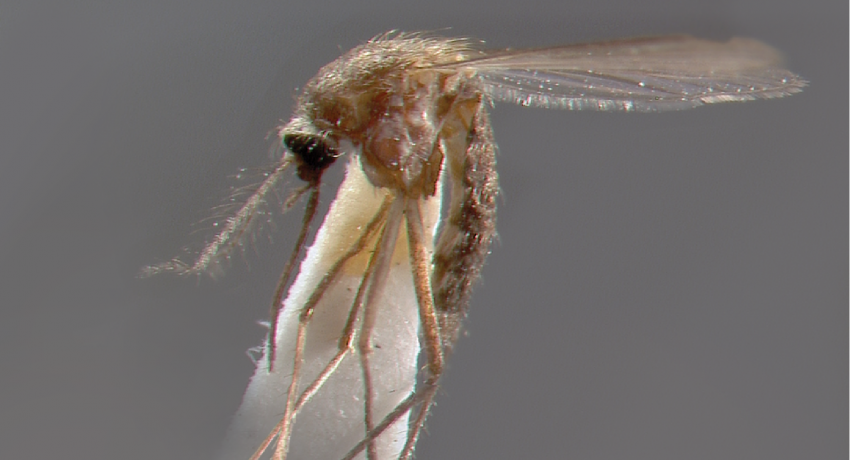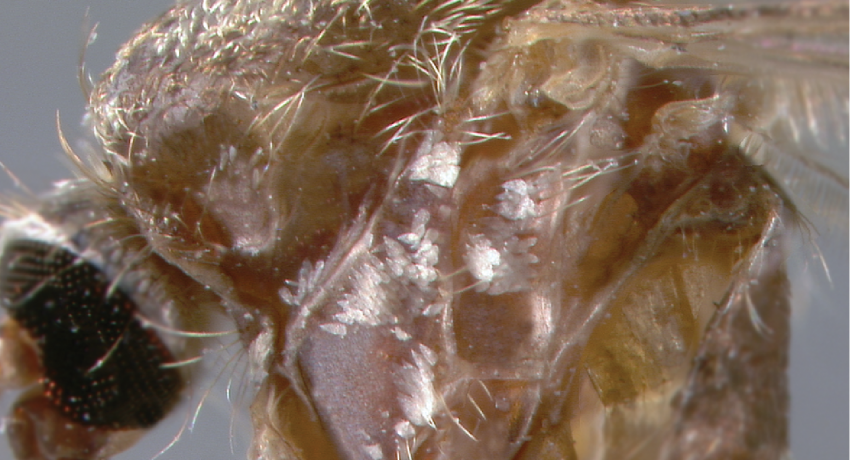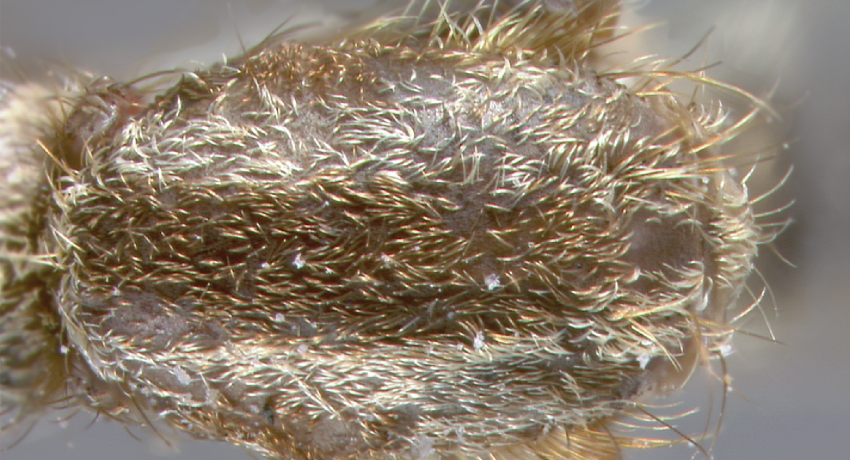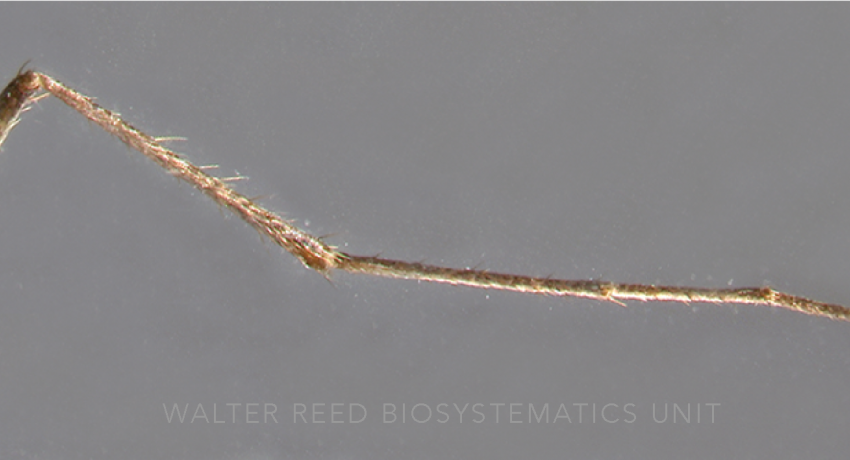NEOTROPICAL REGION
Informal name: Narrow-banded Costa Rican Pointy Mosquito
Etymology: narrow stripes (L); refers to stripes on thorax
Aedes angustivittatus is one of the most common Aedes in Central America. Aedes angustivittatus belongs to the Trivittatus Subgroup (Scapularis Group, subgenus Ochlerotatus), together with Ae. atactavittatus Arnell, Ae. meprai Martinez & Prosen, and Ae. trivittatus (Coquillett). Hybridization may occur between Ae. angustivittatus and Ae. trivittatus where their ranges overlap.
Type locality: Port Limon, Costa Rica
Type depository: U.S. National Museum, Washington, D.C., United States (USNM)
DIAGNOSTIC CHARACTERS (Click photos to view; mouse over and click large photo to zoom in.)
ADULT (illustrated): Thorax: Lower mesepimeral setae absent; scutum with broad lateral pale scaled areas; scutum with narrow, curved scales. Legs: Ta-I-III without pale bands; Fe-I–III without apical white spots; Ti-III with anterior stripe of white scales.
LARVA (not illustrated): Head: Setae 5,6-C single. Thorax: Integumental spicules long. Abdominal segments: Seta 1-IV,V usually double. Terminal segments: Comb scales (CS) with many subequal spinules.
TAXONOMIC KEYS
![]()
WRBU – Aedes – Neotropical Region – Larva
Exemplar DNA sequences
Ae. angustivittatus COI: KM592987, KM593061, KY859903–918
BIONOMICS
Immatures
Aedes angustivittatus is a floodwater mosquito, depositing its eggs in the upper layer of the soil in wooded areas, in sites that are likely to flood. Immature sites often include temporary ground pools formed by rains and stream overflow, pools in drying or intermittent streams, animal hoof prints in marshy pastures and margins of freshwater swamps and ponds.
Adults
Usually crepuscular and predominantly mammalophilic, Ae. angustivittatus will readiy feed on man if disturbed during the daytime in shaded areas. Primarily a lowland species, Ae. angustivittatus have been collected at elevations up to 2000m. Aedes angustivittatus is utilized by the bot fly Dermatobia hominis (Diptera: Oestridae) as a phoretic host of its eggs.
DISTRIBUTION NOTES
Argentina, Belize, Bolivia, Brazil, Colombia, Costa Rica, Ecuador, El Salvador, Guatemala, Honduras, Mexico, Nicaragua, Panama, Peru, Venezuela.

WRBU VECTOR HAZARD REPORTS
None; View other WRBU Vector Hazard Reports
Available GIS Models:
Ae_angustivittatus_Dornak_1 South & Central America
IMPORTANT REFERENCES (full citations below)
Dyar & Knab 1907a: 9 (M, F; as Aedes)
Lane 1953: 670 (M*, F, L*)
Stone & Knight 1956a: 214 (type information)
Ronderos & García 1963 (1962)a: 37 (P*)
Mohrig 1967 (F*)
Arnell 1976: 29 (M*, F*, P*, L*; distribution)
Pecor et al. 2000 (taxonomy, distribution; Peru)
Berti et al. 2015 (distribution; Venezuela)
CURRENT SYNONYMS
syn. cuneatus Dyar & Knab
1908: 54 (M, F). Type locality: Cordoba, Veracruz, Mexico (USNM). References: Stone & Knight 1956a: 216 (type information, lectotype designation).
syn. argentescens Dyar & Knab
1908: 55 (M, F). Type locality: Cordoba, Vera Cruz, Mexico (USNM). References: Stone & Knight 1956a: 214 (type information, lectotype designation).
syn. traversus Dyar
1925g: 215 (F). Type locality: Zulia River, Venezuela (USNM). References: Stone & Knight 1956a: 226 (type information, lectotype designation).
CITED REFERENCES
Arnell, J. H. (1976). Mosquito studies (Diptera, Culicidae) XXXII. A revision of the scapularis group of Aedes (Ochlerotatus). Contributions of the American Entomological Institute, 13(3).
Berti, J., Guzmán, H., Estrada, Y., & Ramírez, R. (2015). New records of mosquitoes (Diptera: Culicidae) from Bolívar State in South Eastern Venezuela, with 27 new species for the state and 5 of them new in the country. Frontiers in Public Health, 2, 10.
Dyar, H.G. (1925g). Some mosquitoes from Venezuela (Diptera, Culicidae). Insecutor Inscitiae Menstruus, 213–216.
Dyar, H.G., & Knab, F. (1907a). Descriptions of some American mosquitoes. Journal of the New York Entomological Society, 15, 9–13.
Dyar, H.G., & Knab, F. (1908). Descriptions of some new mosquitoes from tropical America. Proceedings of the United States National Museum, 35(1632), 53–70.
Lane, J. (1953). Neotropical Culicidae (Vols. I, II). São Paulo: University of São Paulo.
Pecor, J.E., Jones, J., Turell, M.J., Fernancez, R., Carbajal, F., O'Guinn, M., . . . Klein, T.A. (2000). Annotated checklist of the mosquito species encountered during arboviral studies in Iquitos, Peru (Diptera: Culicidae). Journal of the American Mosquito Control Association, 16, 210–218.
Ronderos, R.A., & García, M. (1963a). Description de pupas de Aedes argentinos (Diptera-Culicidae). Revista de la Sociedad Entomologica Argentina, (1962), 25, 35–37.
Stone, A., & Knight, K.L. (1956a). Type specimens of mosquitoes in the United States National Museum. II. The genus Aedes (Diptera, Culicidae). Journal of the Washington Academy of Sciences, 46(7), 213–228.
CITE THIS PAGE
Walter Reed Biosystematics Unit (Year). Aedes angustivittatus species page. Walter Reed Biosystematics Unit Website, http://wrbu.si.edu/vectorspecies/mosquitoes/angustivittatus, accessed on [date (e.g. 03 February 2020) when you last viewed the site].










































































































































































